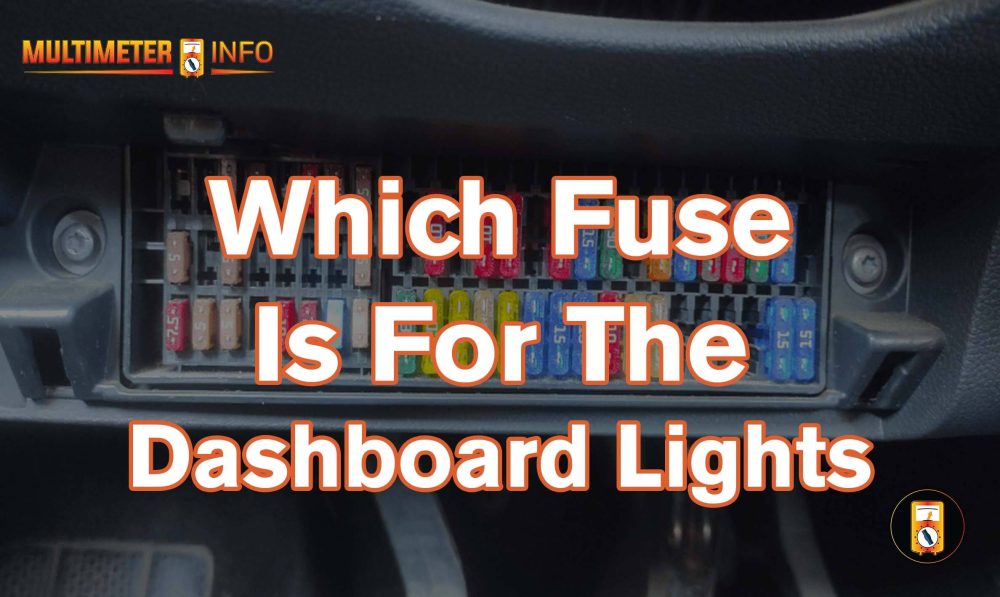Most cars have several electrical components, which can be prone to problems. Unfortunately, these issues can lead to various symptoms, such as lights going out on the dashboard or other electrical systems failing to work correctly. If you experience any of these symptoms, it could be due to a blown fuse in your car’s wiring system. In this blog post, we’ll discuss how you can locate and replace the correct fuse when your car’s dashboard lights fail and diagnose any underlying faults that might be causing the issue.

Understanding The Different Types of Fuses:
Apart from dashboard light fuses, other types of fuses serve different purposes. The most common ones include the following:
High-amperage fuses:
These are typically located in the power distribution box and have higher amperage ratings (10 amps to 20 amps) than blade fuses. They protect major vehicle components from over-current or short circuits.
Cartridge Fuses:
Depending on the application, these also have high current ratings, usually 30-50 amps or more. They are made to replace circuit breakers quickly and are often found in the engine compartments of modern cars.
Miniature Fuse:
This type of fuse is used to protect small components such as interior lights or power windows. They can handle less current than blade fuses and come in different sizes.
Glass Fuse:
This fuse is made from glass and is designed to melt when the current draw exceeds its amperage ratings, thus cutting off the circuit. It’s used for general-purpose protection of wiring and other vehicle components.
Knowing the different kinds of fuses and how they can ensure your car’s electrical system is safe and working well. Check your car’s owner’s manual for specific information on which type of fuse should be used in each application. If you take care of your car, it will last longer, and you won’t have to pay for any expensive repairs.
Which Fuse is for The Dashboard Lights:
When diagnosing an issue with your car’s dashboard lights, you may need to check the fuse box for a faulty or blown a fuse. Most cars have at least one fuse box in three locations: under the car’s hood, beneath the dashboard, and close to the glove compartment. Once you locate the desired fuse box, find a diagram with specifications for which fuse protects the “dash lights” or “lights.”
This type of blade fuse usually has a low amp rating (between 5 amps and 7 amps) and is made to protect any wiring from short circuits and other electrical problems caused by too much current. It is vital to ensure that this type of safety feature is working properly as it can prevent further damage to the electrical system.
When troubleshooting an issue with your car’s dashboard lights, checking the fuse box is an excellent place to start. Look for a diagram specifying which blade fuse controls the “dash lights” or “lights,” and ensure this vital safety feature works correctly so you can drive safely.
How to Locate the Dashboard Lights Fuse?
Once you have located the fuse box, look for a diagram that indicates the “dash lights” or “lights” fuse. The diagram may be labelled on the top of the box or printed in your car manual. If there is no diagram, check beneath the lid for labels identifying each fuse inside.
Please turn off any power sources before attempting to access the fuse box and its components. Identifying a replacement fuse with an amperage rating identical to the existing one is also essential – otherwise, this could lead to more serious problems. Once you have found and replaced the dashboard light fuse as necessary, re-establish any power connections and test the lights to ensure they work correctly.
If you find that your dashboard lights remain inoperable, it is advisable to contact an automotive technician for help. With their expertise, they can assess the problem and provide a solution.
HOW TO FIX DASHBOARD LIGHTS?
When dashboard lights fail, it is vital to take the necessary steps to establish the cause and perform any required repairs. As a general rule of thumb, it is always best to refer to your car’s owner’s manual for specific instructions for dashboard lights and other systems within your vehicle. However, if you do not have access to this document, here are some tips that may help diagnose and repair your dashboard light problem:
Diagnose the Problem:
- Check your car’s dashboard warning lights, and determine which lights have gone out. If a single light is out, it could indicate a malfunction in the wiring or lamp itself. However, if several lights are out simultaneously, this could suggest a more serious problem with your car’s electrical system.
Check Fuses and Relays:
- Locate your car’s fuse box and look for a diagram that indicates the “dash lights” or “lights” fuse. The diagram may be labelled on the top of the box or printed in your car manual. If there is no diagram, check beneath the lid for labels identifying each fuse inside.
- Please turn off any power sources before attempting to access the fuse box and its components. Identifying a replacement fuse with an amperage rating identical to the existing one is also essential – otherwise, this could lead to more serious problems. Once you have found and replaced the dashboard light fuse as necessary, reassemble all components and test to see if this has resolved your issue.
Check Wiring and Connectors:
- If the replacement fuse does not bring your dashboard lights back to life, checking the wiring inside your car’s electrical system may be necessary. You can use a multimeter to test for voltage on the circuit powering your dashboard lights. Look for loose or corroded connectors, and ensure they are securely fastened before testing again.
Consider Replacing Lights:
- After ensuring that all of the wiring and fuses are in good working order, one or more of the individual lamps may have failed, necessitating replacement for your dashboard lights to function correctly; carefully remove the faulty lamps and look for compatible replacements at a local auto parts store.
If you follow the steps above, you should be able to figure out what’s wrong with most dashboard lights and fix them. But let’s say you can’t solve the problem alone or don’t like doing what needs to be done. In that case, you should get your car serviced as soon as possible by a professional. This will ensure that all the wires are securely connected and that your car’s electrical system doesn’t worsen.
Frequently Asked Questions:
The most common fuse used in vehicle dashboards is a spade-type blade fuse. These fuses are relatively easy to identify and replace, as they come in various sizes corresponding to different amperages.
You can typically find the correct size fuse at auto parts or hardware stores. Check your vehicle’s owner’s manual before purchasing a replacement fuse so you know what size to buy.
Before changing any fuses, it is vital to disconnect the battery from the vehicle. Once disconnected, you can carefully remove the old fuse and replace it with a new one of an equal amperage rating. If you do not have a manual that states what amperage rating your fuse should be, consult a qualified technician for assistance. After replacing the fuse, reattach the battery and check to make sure all dashboard lights are working correctly.
If a fuse repeatedly blows, it could indicate a problem with one of the electrical components connected to the dashboard lights. It’s best to consult an automotive technician who can diagnose and repair the underlying issue before replacing any more fuses.
Conclusion:
Finally, remember that the dashboard light fuse can be found in the fuse box, typically under the hood, beneath the dashboard, or near the glove compartment. The precise location of this fuse will vary depending on the make and model of your vehicle, so consult your owner’s manual for more specific information. Additionally, look for a diagram labelling each fuse within the box. This should assist you in determining which one is in charge of powering the dashboard lights. With this knowledge, replacing a faulty dash light fuse should be a quick and easy task.




